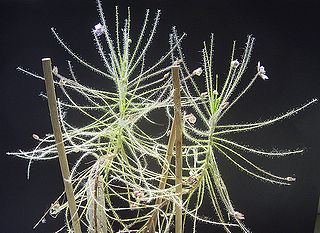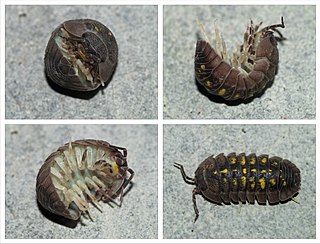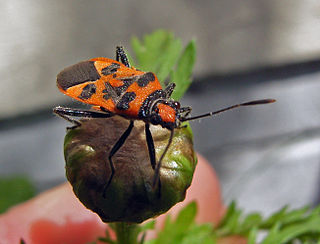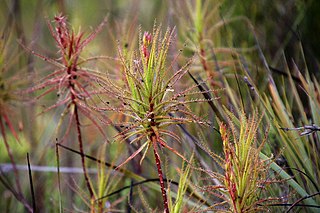
Daffy Duck is a cartoon character created by animators Tex Avery and Bob Clampett for Leon Schlesinger Productions. Styled as an anthropomorphic black duck, he has appeared in cartoon series such as Looney Tunes and Merrie Melodies, in which he is usually depicted as a foil for either Bugs Bunny, Porky Pig or Speedy Gonzales. He was one of the first of the new "screwball" characters that emerged in the late 1930s to replace traditional everyman characters who were more popular earlier in the decade, such as Mickey Mouse, Porky Pig, and Popeye.

Hemiptera is an order of insects, commonly called true bugs, comprising over 80,000 species within groups such as the cicadas, aphids, planthoppers, leafhoppers, assassin bugs, bed bugs, and shield bugs. They range in size from 1 mm (0.04 in) to around 15 cm (6 in), and share a common arrangement of piercing-sucking mouthparts. The name "true bugs" is often limited to the suborder Heteroptera.

The Pentatomoidea are a superfamily of insects in the suborder Heteroptera of the order Hemiptera. As hemipterans, they possess a common arrangement of sucking mouthparts. The roughly 7000 species under Pentatomoidea are divided into 21 families. Among these are the stink bugs and shield bugs, jewel bugs, giant shield bugs, and burrower bugs.

Byblis is a small genus of carnivorous plants, sometimes termed the rainbow plants for the attractive appearance of their mucilage-covered leaves in bright sunshine. Native to Australia and New Guinea, it is the only genus in the family Byblidaceae. The first species in the genus was described by the English botanist Richard Anthony Salisbury in 1808. Eight species are now recognised.

Lola Bunny is a Looney Tunes cartoon character portrayed as an anthropomorphic female bunny created by Warner Bros. Pictures. She is generally depicted as Bugs Bunny's girlfriend. She first appeared in the 1996 film Space Jam.

Roridula is a genus of evergreen, insect-trapping shrubs, with two species, of about 1⅓–2 m. It is the only genus in the family Roridulaceae. It has thin, woody, shyly branching, upright, initially brown, later grey stems, with lance- to awl-shaped leaves crowded at their tips. The star-symmetrical flowers consist from the outside in of five, green or reddish, free sepals, alternating with five white, pink or purple, free petals. Further to the middle and opposite the sepals are five stamens with the anthers initially kinked down. These suddenly flip up if the nectar-containing swelling at its base is being touched. The center of the flower is occupied by a superior ovary. The leaves and sepals carry many sticky tentacles of different sizes, that trap insects. Roridula does not break down the insect proteins, but bugs of the genus Pameridea prey on the trapped insects. These later deposit their feces on the leaves, which take up nutrients from the droppings. The species can be found in the Western Cape province of South Africa. They are commonly known as dewstick or fly bush in English and vlieëbos or vlieëbossie in Afrikaans.

Armadillidiidae is a family of woodlice, a terrestrial crustacean group in the order Isopoda. Unlike members of some other woodlice families, members of this family can roll into a ball, an ability they share with the outwardly similar but unrelated pill millipedes and other animals. This ability gives woodlice in this family their common names of pill bugs or roly polies. Other common names include slaters, potato bugs, butchy boys, and doodle bugs. Most species are native to the Mediterranean Basin, while a few species have wider European distributions. The best-known species, Armadillidium vulgare, was introduced to New England in the early 19th century and has become widespread throughout North America.

Coreoidea is a superfamily of true bugs in the infraorder Pentatomomorpha which includes leaf-footed bugs and allies. There are more than 3,300 described species in Coreoidea.

Anthocoridae is a family of bugs, commonly called minute pirate bugs or flower bugs. Worldwide there are 500-600 species.
The Java language has undergone several changes since JDK 1.0 as well as numerous additions of classes and packages to the standard library. Since J2SE 1.4, the evolution of the Java language has been governed by the Java Community Process (JCP), which uses Java Specification Requests (JSRs) to propose and specify additions and changes to the Java platform. The language is specified by the Java Language Specification (JLS); changes to the JLS are managed under JSR 901. In September 2017, Mark Reinhold, chief Architect of the Java Platform, proposed to change the release train to "one feature release every six months" rather than the then-current two-year schedule. This proposal took effect for all following versions, and is still the current release schedule.

Berytidae is a family of the order Hemiptera, commonly called stilt bugs or thread bugs. Most berytids are brown to yellow, with species that are plant sap feeders, a few being predaceous. About 200 species are known from all around the world and they are classified into three subfamilies.

A protocarnivorous plant, according to some definitions, traps and kills insects or other animals but lacks the ability to either directly digest or absorb nutrients from its prey like a carnivorous plant. The morphological adaptations such as sticky trichomes or pitfall traps of protocarnivorous plants parallel the trap structures of confirmed carnivorous plants.

Pameridea is a genus of insects comprising two species, P. roridulae and P. marlothii, that live in symbiotic relationships with carnivorous plants in the genus Roridula. Pameridea marlothii only occurs on R. dentata, while P. roridulae exists on both R. dentata and R. gorgonias.

Roridula dentata is a protocarnivorous plant native to the Western Cape province of South Africa.

Roridula gorgonias is an evergreen, shyly branching, upright shrub of up to about 1 m (3 ft) high, from the family Roridulaceae. It has awl-shaped leaves with entire margins, crowded at the tip of the branches. These are set with tentacles that secrete a sticky, shiny resin from the thicker gland at their tips, that catch many airborne items. At the center of the shoots appear inflorescences between July and October that consist of up to twelve flowers in spikes, each on a short flower stalk, with a bract at its base. The 5-merous flower is about 2½ cm (1 in) in diameter and has pinkish purple or white petals. The plants do not digest the trapped insects, but the bug Pameridea roridulae sucks out their juices and the plant absorbs nutrients from the bug's droppings. It is therefore considered a protocarnivorous plant. It is called Gorgons dewstick, fly bush or fly catcher bush in English and vliebos, or vlieëbossie in Afrikaans.. R. gorgonias is an endemic species home to the southwest of the Western Cape province of South Africa.

Carnivorous plants are plants that derive some or most of their nutrients from trapping and consuming animals or protozoans, typically insects and other arthropods, and occasionally small mammals and birds. They still generate all of their energy from photosynthesis. They have adapted to grow in waterlogged sunny places where the soil is thin or poor in nutrients, especially nitrogen, such as acidic bogs. They can be found on all continents except Antarctica, as well as many Pacific islands. In 1875, Charles Darwin published Insectivorous Plants, the first treatise to recognize the significance of carnivory in plants, describing years of painstaking research.

The term year 2000 problem, or simply Y2K, refers to potential computer errors related to the formatting and storage of calendar data for dates in and after the year 2000. Many programs represented four-digit years with only the final two digits, making the year 2000 indistinguishable from 1900. Computer systems' inability to distinguish dates correctly had the potential to bring down worldwide infrastructures for computer reliant industries.
Infestation is the state of being invaded or overrun by pests or parasites. It can also refer to the actual organisms living on or within a host.

Dicyphini is a tribe of bugs in the family Miridae.

A gnat is any of many species of tiny flying insects in the dipterid suborder Nematocera, especially those in the families Mycetophilidae, Anisopodidae and Sciaridae. Most often they fly in large numbers, called clouds. "Gnat" is a loose descriptive category rather than a phylogenetic or other technical term, so there is no scientific consensus on what constitutes a gnat. Some entomologists consider only non-biting flies to be gnats. Certain universities and institutes also distinguish eye gnats: the Smithsonian Institution describes them as "non-biting flies, no bigger than a few grains of salt, ... attracted to fluids secreted by your eyes".


















